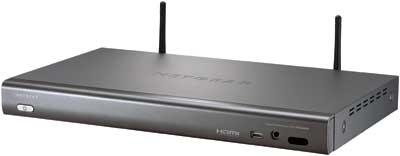Whole Lotta Convergence Goin' On

| Netgear's EVA8000 Digital Entertainer HD streams YouTube videos directly to your TV. |
The bigscreen displays at CES are decidedly hi-def, but in an age when anybody can post a video, CE manufacturers are suddenly touting their products' prowess connecting to anything that moves on the Internet. We saw a slew of announcements intended to let consumers watch pixel-challenged videos, better suited for a corner of a computer screen, on their 50-inch displays.
Netgear, for example, introduced a wired and wireless (802.11g) media receiver that enables you to stream YouTube videos directly to your TV. Ironically, the receiver is called the EVA8000 Digital Entertainer HD and seems to be the first such device with HDMI for streaming high-definition movies at up to 1080p. But still, what did Netgear demo? The Extreme Diet Coke & Mentos Experiments, a YouTube hit in which men in lab coats mock the Bellagio fountains by dropping mints into an array of soda bottles. It's cute but a far cry from 1080p.
The receiver also streams songs, including ones purchased from the iTunes Music Store, from a Windows computer but not a Mac. A Netgear official refused to explain how the company got around Apple's Fairplay restrictions. The EVA8000 will be available in the first quarter for $349.
SanDisk offered a sneakernet solution for watching videos downloaded from the Internet on your TV. Referring to it as a "flash DVD player," the USBTV is actually a USB flash drive that you use to copy videos or other content from your computer. You then walk it over to its mate, a cradle containing a multimedia processor that plugs into any TV's S-video input. It comes with a small remote and is expected to be available in 2- and 4-gigabyte versions in March at an undisclosed price.
"In the convergence of the Web and home entertainment, USBTV solves in a simple, elegant way the last 10-feet of the content portability problem in the home between the PC and the TV," declared SanDisk CEO Eli Harari. The company says it is in discussions with LG, Mitsubishi, and Pioneer about adding connectors and embedded software into next-generation TVs so cradles wouldn't be necessary.




























































